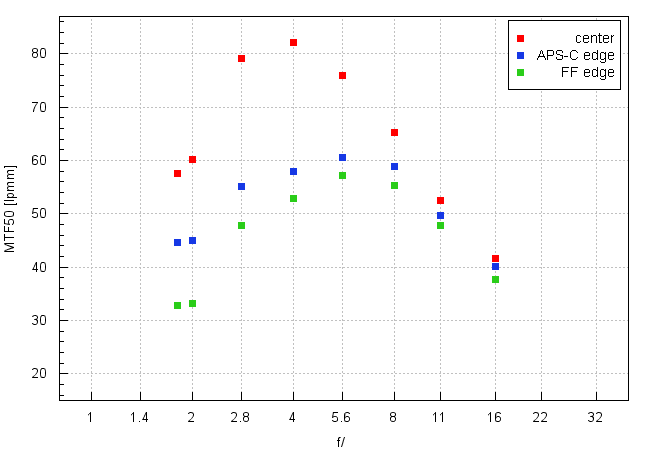Nikon Nikkor Z 35 mm f/1.8 S
4. Image resolution
Let's see how the Nikkor Z 35 mm f/1.8 S compares – its results in the frame centre and on the edge of the APS-C/DX sensor and on the edge of full frame presents a graph below.

Please Support UsIf you enjoy our reviews and articles, and you want us to continue our work please, support our website by donating through PayPal. The funds are going to be used for paying our editorial team, renting servers, and equipping our testing studio; only that way we will be able to continue providing you interesting content for free. |
- - - - - - - - - - - - - - - - - - - - - - - - - - - - - - - - - - - - - - - - - - - - - - - -
In the frame centre the image quality is good up from the maximum relative aperture. The results we got in that place are around 58-60 lpmm so noticeably higher than the decency level. What's more, on stopping down the aperture the resolution improves very quickly – by f/2.8 the lens gets to 79 lpmm and by f/4.0 the lens reaches the peak of its performance, with an excellent value of over 82 lpmm.
The performance on the edge of the APS-C/DX sensor is also good. Even at the maximum relative aperture the images are fully useful and on stopping down to near f/5.6 the lens is able to reach a very high level of 60 lpmm.
The only reservation concerns the edge of full frame - by f/1.8 and f/2.0 the resolution can hardly be called acceptable as the results we got reached just about 33 lpmm. Fortunately on stopping down the image quality improves very quickly and already by f/2.5 you can enjoy photos of sensibly good resolution.
Our overall assessment of the performance of the Nikkor Z 35 mm f/1.8 S can only be very favourable. Of course you might wonder whether or not optics specialists could have made the end of the frame better, improved the performance near the maximum relative aperture and reduced differences between the centre and the edge of the frame. To be honest such correction is nothing easy – other lenses with similar parameters haven't been perfectly corrected in this category either. The reflex camera Nikkor AF-S 35 mm f/1.8G ED fared weaker from almost every aspect. The Tamron SP 35 mm f/1.8 Di VC USD fared similarly well and on the edge of full frame also had to be stopped down to near f/2.5 in order to get a sensible image quality. A bit slower Canon EF 35 mm f/2 IS USM also experienced a lot of problems on the edge of full frame. As you see, after all, the performance of the Nikkor Z 35 mm f/1.8 S compares very favourably with the performance of other optical constructions featuring similar parameters so we think the results of the tested lens should still be praised.
At the end of this chapter, traditionally, we present crops taken from photos of our resolution testing chart which were saved as JPEG files along the RAW files, used for the analysis above.
| Nikon Z7, JPEG, f/1.8 |
 |
| Nikon Z7, JPEG, f/4.0 |
 |






